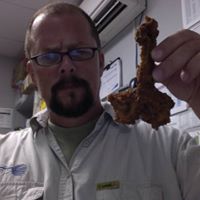Leaderboard
Popular Content
Showing content with the highest reputation on 03/31/2010 in all areas
-
How many of you carry printed Vial of Life papers to pass out to anyone who comes to your station, or stops your ambulance if you stage in different places. Theres so many people that dont know about these sheets that not only make our jobs easier but they can prevent possible mistakes from being made due to the pt being unable to speak for whatever reason, or a mother who is losing it and cant tell you what is wrong with her child. Something to think about. Get them printed and get them out there, its a free 1 page print of the vial of life website.6 points
-
I know this is not the topic, but the removal of Boards from Ambulance should be considered very carefully. Australia and New Zealand Services have always had a rather negative view towards Full Spine Immobilisation and Long Spine Boards. Part of this has been due to the US practice of everyone gets Boarded and both countries did not want to move down such a track. The use of Spine Boards have as a result been limited in their use, poorly taught to staff, discouraged from use, or not even as yet introduced into some Services. I have taught Board usage to 1000's of students throughout Australia, to New Zealand Paramedic students, and recently completed a 3 month study tour of the US, Europe and the UK. What was clearly evident was the lack of understanding and versatility of the Board, and research relating to it's usage. I will not enter the debate as to whether Full Spine immobilisation is necessary will go on for many years, as for every argument for it, there is a argument against. Spinal clearance protocols are clearly of benefit for reducing unnecessary immobilisation that was so passionately feared in Australia and New Zealand. But lets focus just on the Board itself. In the Victorian Ambulance Service - Australia, Long Spine Boards were only introduced into Service in 1996. The introduction of the Board into Victoria was successful as it was a result of extensive research into current literature, looking at what was available, how it was being used, advantages and disadvantages of the device, limitations, when is should and shouldn't be used, and addressed the many shortcomings of design and application complained by so many. By teaching a true understanding of the device and the multitude of applications (spinal forms only a small part of the Boards actual uses), and introducing properly designed equipment based on research (that was also user friendly), the Board was a massive success, and even resulted in a significant reduction in back injuries amongst Ambulance Officers. The failing and/or negativity of the Board by so many is that research has progressed, but design and application of the Board is still in many Services based to practices of the 1960's. Example: a number of Australian Ambulance Services use a curved Board rather than a flat board. A recent study from the USA (Prehosp Emerg Care. 2006 Jan-Mar;10(1):46-51. Comparison of the Ferno Scoop Stretcher with the flat long backboard for spinal immobilization) and a second study from Australia (Lee Deacon University Victoria 2007 Preparation For The Research & Development Of A New Generation Long Spine Board) finally recognised the benefit of curvature, but most of the world continues using a flat design that actually dates back to the 1800's when coffin lids were used as makeshift backboards. Further, the biggest arguments against the Boards is pressure sores and discomfort. Multiple studies confirm an unpadded Board is uncomfortable, misaligns the spine, and leads to pressure sore development. Some of these studies include: 1. Patterson RP, et al Phys Rehabil 1988;67:123–7. Risk factors for early occurring pressure ulcers following spinal cord injury. 2. Delbridge TR, et al Prehosp Disast Med 1993;8. Discomfort in healthy volunteers immobilized on wooden backboards and vacuum mattress splints. 3. Lovell, et al Injury. 1994 Apr;25(3):179-80. A comparison of the spinal board and the vacuum stretcher, spinal stability and interface pressure. 4. Chan D, et al Ann Emerg Med 1994 Jan;23(1):48-51. The effect of spinal immobilization on healthy volunteers. 5. Chan D, et al . J Emerg Med 1996 May-Jun;14(3):293-8. Backboard versus mattress splint immobilization: a comparison of symptoms generated. 6. Hamilton RS, et al J Emerg Med 1996 Sep-Oct;14(5):553-9. The efficacy and comfort of full-body vacuum splints for cervical-spine immobilization. 7. Lerner EB, et al Prehosp Emerg Care 1998 Apr-Jun;2(2):112-6. The effects of neutral positioning with & without padding on spinal immobilization of healthy subjects. 8. Cross DA, et al Prehosp Emerg Care 2001 Jul-Sep;5(3):270-4. Comparison of perceived pain with different immobilization techniques. 9. Vickery, et al Emerg Med J 2001;18:51-54 doi:10.1136/emj.18.1.51. The use of the spinal board after the pre-hospital phase of trauma management As a result of these studies, many argue for the removal of the Board. But research clearly shows that these issues are resolved by the simple application of padding. Studies include: 1. Walton, et al Acad Emerg Med 1995 Aug;2(8):725-8. Padded vs unpadded spine board for cervical spine immobilization 2. Cordell, et al Ann Emerg Med 1995 Jul;26(1):31-6. Pain and tissue-interface pressures during spine-board immobilization. 3. Sheerin, et al J Emerg Nurs. 2007 Oct;33(5):447-50. The occipital and sacral pressures experienced by healthy volunteers under spinal immobilization: a trial of three surfaces. 4. Treseder, et al Ann Emer Med Vol 44 (Oct 2004). Efficiay of an inflatable Spine Board Padding device in reducing pain during simulated spinal immobilisation 5. Hann, Response Volume 33 2006. Long Spine Board: Does It Cause Discomfort 6. Lee, Deacon University Victoria 2007. Preparation For The Research & Development Of A New Generation Long Spine Board 7. Hemmes, et al The Journal of Trauma: Injury, Infection, and Critical Care: March 2010 - Volume 68 - Issue 3 - pp 593-598. Reduced Tissue-Interface Pressure and Increased Comfort on a Newly Developed Soft-Layered Long Spineboard So before you think about removing a Board, think very carefully and research what you are really doing. The research does not support the removal of Boards, only a change in equipment design and how we use them. And back only the topic at hand, use of a Board to rapidly move and extricate a post arrest patient, and if required perform CPR (on a soft stretcher mattress) and even Defib (rather than on a metalised Scoop), what better device is there. Anthony2 points
-
Vial of Life Not a bad idea. I'm gonna make some copies and start handing these out. Heck if time provides I'll just fill the darn thing out for them. This would be so handy if people had this or something to its effect. Thanks for the reminder of such a handy tool.1 point
-
Its standard usage here...we have had several types in the past. We have the pill bottle type with the form kept inside and advise all patients to place the vial in the freezer or on the door of the fridge. We also have a sticker that is placed on the fridge. The other type (less expensive) is a magnetic sleeve that sticks to the fridge. Problem is they are issued and 50% of them are filled out. I think it would be best to have your PIO go door to door and assist them being filled out...yeah it would be time consuming but it is good pr.1 point
-
1 point
-
1 point
-
Let me spring a few more airway situations on you which is now seen more often in the field for EMT(P)s as there are more subacute facilities and home care patients with tracheotomies and tracheostomies or stomas. When you pick up a "trach patient" do you assume it is a "trach" like the one shown in the EMT(P) textbooks or do you examine for brand, model, size and if it has a 15 mm adapter? What if you have a patient with a false tracted trach? Do you know how to recognize it and how long would you attempt to recannulate (with another trach or ETT) before you moved to oral intubation? What if the trach was for tracheal stenosis above the trach site? Are you familiar with Blum-Singer (speaking) valves in stomas? Or, the fistula that may exist between the trachea and esophagus for speaking valves of laryngectomy patients? Can you immediately recognize a flesh colored stoma covering on a patient? This is a good mall people watching activity. These patients may be young and active. They may be in biking or motor vehicle accidents and anywhere else that you would not expect to be faced with an alternative airway situation. BLS: How do you manage the airway of a stoma patient? Sidenote: a tracheostomy/stoma may be found in pediatric patients who are in long term care and/or vegetative states to prevent aspiration. What about all the numerous tracheotomy/tracheostomy devices that don't have a regular 15 mm adapter for the BVM? Montgomery tubes, Singer laryngectomy tubes and Shiley trachs missing their inner cannulas are examples of this. Has anyone seen an innominate artery blow? Was this discussed in your cricothryoidotomy or trach class? Reconstructive surgery and/or radiation may make land marks difficult to identify if you do need to perform a cricothryoidotomy. Some interesting websites: Prostetic speaking valve and stoma/fistula coverings http://www.google.com/imgres?imgurl=http://www.epithesen.com/images/trach6.jpg&imgrefurl=http://www.epithesen.com/engl/tracheostoma.htm&h=283&w=368&sz=18&tbnid=BTBikyToolDgGM:&tbnh=94&tbnw=122&prev=/images%3Fq%3DBlom%2Bsinger%2Bvalve&hl=en&usg=__kBol3Gh-SpoB1ctYsCvxWM5n45o=&ei=sW-yS9GSOoyOswOUl6DMAw&sa=X&oi=image_result&resnum=10&ct=image&ved=0CCcQ9QEwCQ Speaking valve for laryngectomy patients http://img.medscape.com/pi/emed/ckb/otolaryngology/834279-883689-33.jpg Voice restoration for laryngectomy patients and the founders of the technology. (Some great information on this website especially under Educational Resources.) http://www.inhealth.com/Blom-Singer_30years.htm Larygectomy products and literature http://www.inhealth.com/literature.htm Montgomery Tubes (note that some look like dry wall hangers and may have been surgically placed.) http://www.bosmed.com/airway-management/montgomeryr-cannula-system.html These are just a few things to read about. RTs and ENTs get called almost every day to the ED by the ED doctors to identify and manage a funky looking device sticking out of someone's throat that was placed for some special reason by a Specialist. "Trach" is a catch all term but may not be the appropriate one to use when giving report. Others may "assume trach" and be caught off guard in an emergency by a specialized device.1 point
-
Just a re-stating of what I know I have put into other threads: Be respectful of those who were already on the scene, and don't just push them out of the way. An EMT of my acquaintance successfully sued a Paramedic from her agency for assault and battery. Seems he didn't realize she was an EMT, as she was out of uniform and had stopped at a street side incident in her POV, and physically pushed her out of the way so hard, she fell and sustained an injury. Our "hero para-god" had done a deed I have always called "Paramedic Shove". I don't care what level you operate at, or who you have higher level of training over, don't commit Paramedic Shove, as the person you push might have Johnny Cochran's Law Firm on speed dial!1 point
-
OMFG WHO CARES!!!!!!!!! *pulls hair hair out in clumps1 point
-
1 point
-
I hate these stories and am probably going to get mugged for this opinion. But what the hell? I can see that a habit of this is a problem, but barring the fact that these are a bunch a yahoos and they'll just using this to kick their asses, I don't really see the problem. Dyaln And Babs came to stay for a few days in Trinidad where I work. I let Dylan call us on the car, Dylan,"Trinidad, 3103" , Dispatch,"3103", Dylan,"Good morning. Could you put Womack and XXX on this truck please?" "Copy, and good morning to you!" Now, for those of you that don't know, Dylan is autistic, so this wasn't as smooth in reality is as it in text. Dispatch called a few minutes later to my cell and told me that they thought it was adorable. Now, there certainly was a chance I could have gotten jammed up for inappropriate radio traffic. But you know what? Put the friggin paper in my file...Dylan thought it was cool as hell, and those moments are rare for him, dispatch played along and thought it was cute, response and service was in no way compromised, so screw it. Now, the next time it happens, another time that night, or even next week, when it appears that there is a pattern of disrespect for communications, then it should be an issue. And please folks, I'm begging you, is it possible to forgo the "What if everyone did that!?!" argument? Because everyone isn't doing it, and everyone is never going to. Have a great day all... Dwayne1 point
-
Me and my crew follow the same line on and off duty, if theres a few of you, have one person go and pull bystanders to the side and get the info from whoever saw anything and from anyone who intervened. This of course is all for comparison once you get the story from the pt, it also comes into play if before you can get a good history the pt passes out. The more info the better Taking the people/person to the side and explaining to them to calm down and recall as much as possible I think is key.0 points
-
Well, I've missed the last two episodes, so I am a little behind here. I I just now watched them while waiting for the forum to come back up. But here's the exciting critique of tonight's episode: Ever notice that not a single emergency vehicle in the show is California law compliant with their lights? Cellphone picture taker at shooting scene, lol. That’s realistic! All these people standing around with the suspect outstanding, even cops. Field abx prophylaxis in California, lol. Not in our lifetime. They’ve just about broken Rabbit’s spirit. That too is realistic. Every big department does it sooner or later. Tyler bought himself a $300 Littman, lol. Whacker! Too lazy to put your vest under your shirt, where it belongs? You deserve to die. But at least it covers up those stupid badges. Shooting something out of Tyler’s hand is just way too formula. Doctor walking around in bloody surgical gown. Puhleeze… this is the 21st century. Regardless, I’m beginning to think I’d do her. I still wouldn’t touch the blonde bimbo with AK’s dick though. This is becoming like Star Trek. As soon as you see knew faces, you know they’re fixin’ to become casualties. Sniper wasn’t near as good as his equipment. Poor aim. Trigger jerk. Way to go, blonde bimbo. Just about got the cop killed. Hopefully she’ll lose her ticket next episode. Ambulance on scene with lights running, but engines off? Yeah, everybody does that. Putting a bulky dressing on a GSW over body armour, lol. Marisa’s wings are Air Force Flight Surgeon wings. Puhleeze. Not all bad. It may be improving a bit with the character development, finally. This would have been a great episode to kill off the blonde bimbo though.-1 points






